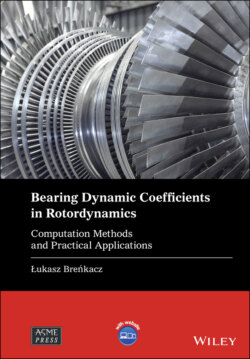Читать книгу Bearing Dynamic Coefficients in Rotordynamics - Lukasz Brenkacz - Страница 12
Preface
ОглавлениеThis monograph concerns the experimental and numerical methods of determination of dynamic coefficients of hydrodynamic radial bearings. Bearings are one of the basic elements influencing the dynamics of rotor machinery. The main parameters with which the operation of bearings can be described (and thus the operation of the entire rotating system) are their stiffness and damping coefficients.
This book includes a chapter about practical applications of bearing dynamic coefficients. It is shown how changes of bearing dynamic coefficients affect the dynamic performance of rotating machinery. Some examples are included with all the necessary data to allow rotordynamics analysis to be conducted and the dynamic coefficients of journal bearings to be calculated so that the readers can replicate the results presented in this book and compare them with their own results. This book presents in detail an experimental method of determining dynamic coefficients of bearings. An additional objective is to describe numerical methods of determining dynamic coefficients of hydrodynamic bearings (linear and non‐linear). The range of applicability of various calculation methods was determined based on measurements made for a rotating machine equipped with hydrodynamic bearings with clearly non‐linear operating characteristics.
Experimental research was carried out with the use of the impulse method, on the basis of which dynamic parameters of hydrodynamic bearings were determined. The applied method with a linear calculation algorithm allows the determination of stiffness and damping coefficients and the determination of mass coefficients in one algorithm. The stiffness and damping coefficients cannot be determined directly, thus indirect calculation methods are used. The mass of the rotor is a directly measurable parameter. Indirectly calculated mass coefficients can be compared with the known mass of the rotor. On this basis, it is possible to make preliminary estimations of the correctness of the results obtained.
As part of the study, the sensitivity analysis of the aforementioned experimental method was carried out with the use of a model created in Samcef Rotors software. The influence of unbalance, displacement of measuring sensors, and various variants of driving force were analyzed. Based on experimental research, dynamic coefficients of hydrodynamic bearings in a wide range of rotational speeds, taking into account resonance speeds and higher speeds, were determined. They were verified using Abaqus software.
Numerical calculations of stiffness and damping coefficients of hydrodynamic bearings with the use of linear and non‐linear calculation models developed by IMP PAN in Gdańsk were also carried out. The obtained results were verified. The stiffness and damping parameters of hydrodynamic bearings determined using numerical models (linear and non‐linear) were compared with the results of experimental research. From this comparison it was possible to evaluate the differences in the values of dynamic coefficients of bearings calculated on the basis of linear and non‐linear numerical methods and the experimental method.
I would like to thank all employees of the Turbine Dynamics and Diagnostics Department of the Polish Academy of Sciences for their kindness, for the atmosphere of friendship that they surrounded me with throughout the entire period of work, and for the fact that I could always count on their support and research experience. In particular, I would like to express my gratitude to Professor Grzegorz Żywica and Professor Jan Kiciński.
Łukasz Breńkacz
Gdańsk, November 2020
